|
||||||

Nine of these islands are not only inhabited, but are home to some of the most amazing resorts in the Caribbean. The islands belong to two countries: St. Vincent and The Grenadines, and Grenada. The first island encountered heading south from St. Vincent is Bequia, the largest and most populated of the islands belonging to St. Vincent (and one of our favorites). Next is Mustique, home of the rich, famous, and fabulous; Canouan (the location of the first mega-resort in the Grenadines; Mayreau, still a real gem (and another favorite); Union Island (arid, boring, and forgettable); Palm Island, currently undergoing a major face-lift; and Petit St. Vincent, a truly private old-money getaway). Continuing south, the Grenadian border is crossed upon reaching Petit Martinique (the reputed smuggling capital of the West Indies). Next is Carriacou, a true step back in time. Finally there is the island of Grenada, signaling the southern conclusion of the Grenadine chain. |
||||||
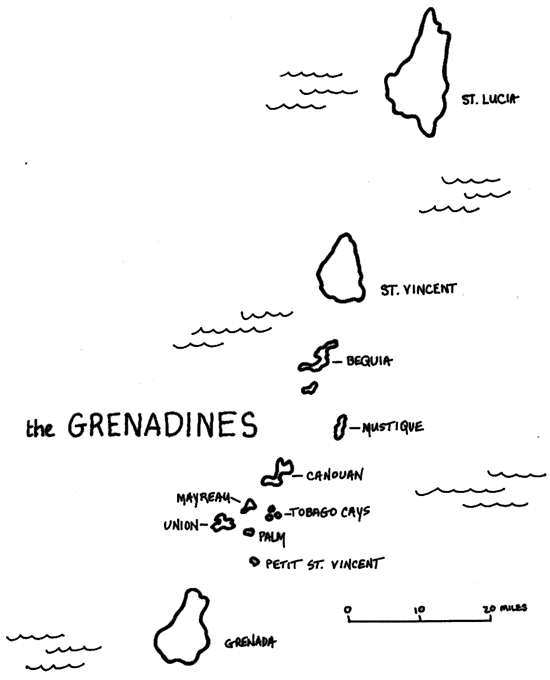
|
||||||
|
|
||||||

The best way to describe Bequia is as the quintessential Caribbean experience - a harmony of all the elements that make the islands special. It is pretty, clean, and small enough to get to know intimately. The local residents are very friendly and responsive. There are handsome beaches, good restaurants, lots of bars, shops, and accommodations that are very reasonably priced. A sea orientation and a yachty element add the perfect touch to the island's ambience. For such a small place it's surprisingly lively. It's easy to spend a week here and not be bored. The action revolves around the waterfront of Port Elizabeth, starting at the ferry dock and winding around the Belmont Walkway to Princess Margaret Beach (also known as Tony Gibbons Beach). Here you can browse in a small but intelligent bookshop, buy some fresh fruit and vegetables from Rastas, have a few drinks, check out the brown coral jewelry displayed by sidewalk vendors, dance to pan music, eat lobster pizza, go scuba diving, buy clothes and T-shirts, have more drinks, and go for a swim at a very pretty beach - all in a half-mile stretch. Bequia has a great mix of people too. In addition to the welcoming locals, there are all kinds of interesting visitors. The island has always attracted an artsy element. The late Sanford Meisner, the famed acting teacher, maintained a house here and often conducted classes and seminars on Bequia. Many artists winter here, finding more than enough inspiration from the surroundings. There are lots of Europeans, especially Germans, who seem to love the island's mellow pace. The North Americans who visit are much more sophisticated than, say, the average tourists who go to Barbados. Bequia appeals to independent travelers (readers, that's you) who are looking for a low-key yet stimulating environment to shake off and forget whatever pressures they have in their everyday worlds. Finally, there are the boat people - the cocktail cruisers who come in on their yachts or charter boats and love to have a good time. They add a little zip and glamour to the mix. |
||||||

|
||||||
|
|
||||||

That's Carriacou. It's on its own wavelength. Everyone - and everything - moves at it's own pace, as did the runway keeper. If you're an efficiency freak or into deluxe accommodations, this island isn't for you. What makes Carriacou special - besides its natural beauty - is a special sense of detachment and the resulting preservation of some unique African/Caribbean customs. After visiting Carriacou several years ago, we thought that there was going to be an intrusion of tourism on the island, but that has just not happened. There may be a few more cruise ships that stop here, taking advantage of Sandy Island, but mostly tourism here is unchanged. As a matter of fact things seem to have gone back in time. The only improvement we saw was that the airstrip was now fenced in (with mechanical gates to let the car and trucks through) - so there will be no more cows on the runway. All the roads on the island are in need of major repair and there was even talk of this happening, but don't count on it any time soon. A few inns and guest houses have popped up, but nothing out the ordinary. There has even been talk of an Italian conglomerate building a 200 room condo/hotel complex up on Windward Heights. We'll believe it when we see it! However, we once were skeptical about plans to develop another Grenadine, Canouan, and it did happen. So who knows? But at this writing you can still get away from it all on Carriacou. There are enough people around to keep your sensibilities alive, and yet a mind-your-own-business philosophy - bred by the big business of smuggling - allows you to socialize only when you want to. There are few activities designed for tourists. Located twenty miles north of Grenada, Carriacou is the largest of the Grenadine chain - but it's still pretty small at eight miles long by five miles wide, and with only about 6,000 inhabitants, most of them in the main town of Hillsborough. It gets extremely dry, almost parched, as the winter progresses. It then begins to look like autumn in New England - give or take a few palm trees and other tropical props. There are several uninhabited "satellite islands" with gorgeous white sand beaches, although lately the best of these - Palm and White islands - have been overrun by passengers from the cruise ships on certain days of the week. |
||||||
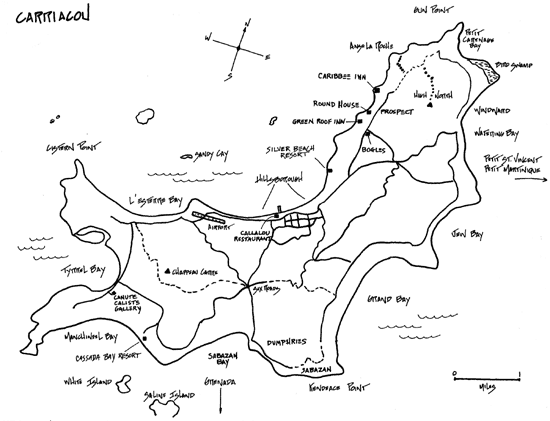
|
||||||
|
|
||||||
 "Dah-ling, it's faboo!" Those are the words we overheard about a waterfront, gorgeous-pool adorned stucco mansion seen as we were landing at Mustique airport's tiny and sloping runway. We later learned it was for sale for millions and millions (way beyond our budget). This made us recall our first impression of Mustique on our initial visit in 1987 to this small, private island of the rich and famous. Arriving by boat (we weren't as well off in those days), we were overwhelmed by the vision of the huge Italianate mansion of Harding Lawrence and ad queen Mary Wells. It still sits on a hilltop like the House of Zeus on Mount Olympus, although the plantings surrounding it have matured and partly shield it from view. Apparently, things haven't changed much here - except that there are a lot more villas on the island and construction seems to be everywhere. H.R.H. Princess Margaret and her son, Viscount Linley, still come here every year to her villa called "Les Jolies Eaux". Schmatta-king Tommy Hilfiger has built a very large, over-the-top mansion that screams "Look at me!" on L'Ansecoy Beach. Down the road is Mick Jagger's Japanese-style beach house and a lesson in good taste - private, secluded, and non-obtrusive. Speaking of rock stars, David Bowie and Elton John have had villas here too. Owned by the Mustique Company, Ltd., this is the Caribbean's small, private Martha's Vineyard without the New England quaintness and restraint. Before being bought by the Company in 1970, it was owned by Lord Glenconner and home to just a few fishermen. Now it is opulent. Many of the villas resemble separate mini-resorts in the Victorian-gingerbread mold, elevated to the appropriate grandness. Besides the Cotton House hotel and the Firefly Guest House, there are only about seventy-five houses on the island. A glance of the property titles would reveal a global representation of the fabulous and fortunate. No cruise ships here, as they and boats with more than twenty-five passengers are prohibited from visiting. Welcome to Mustique, vacationland of the rich, famous, and even more rich. |
||||||
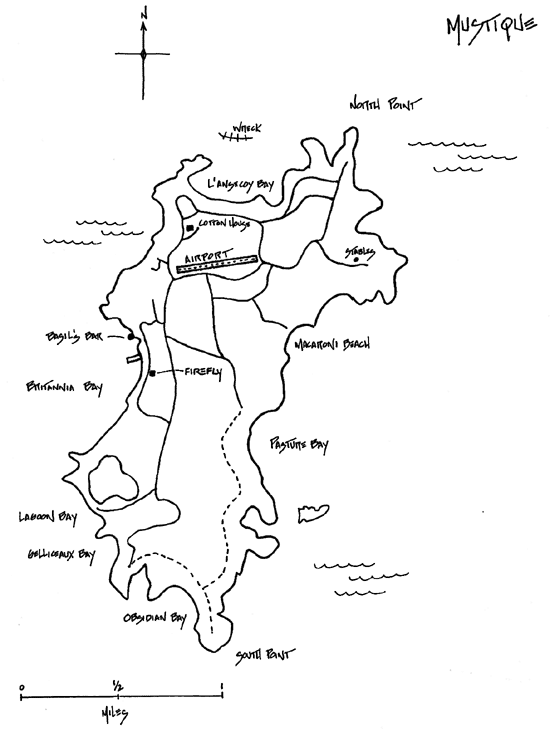
|
||||||
|
|
||||||
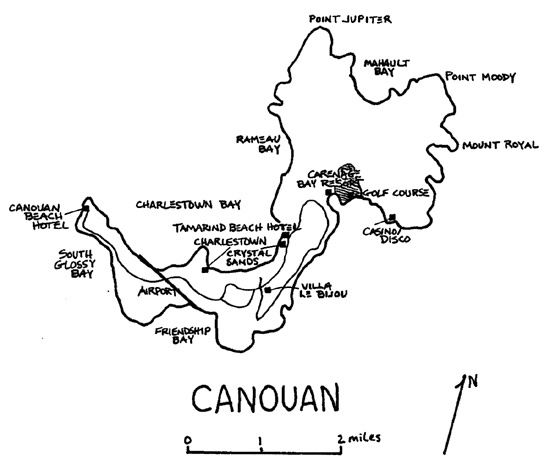 |
||||||
|
|
||||||

After undergoing major renovations and expansion the Palm Island Beach Club re-opened on October 31, 1999. Palm Island is now a high-end, all-inclusive luxury resort. Even though we have not been to the new facility, we suspect that this is another gem in the Grenadines waiting to be discovered. |
||||||
|
|
||||||
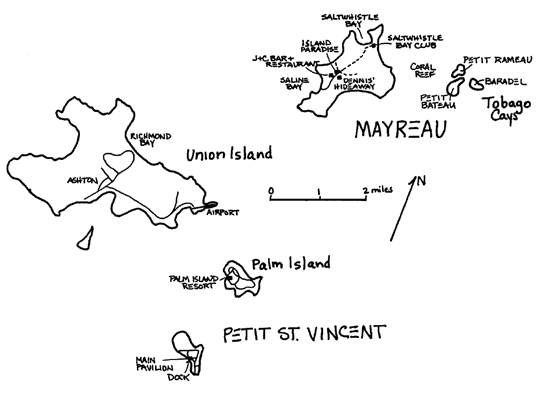 |